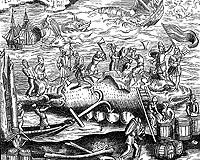| . |  |
. |
San Diego CA (SPX) May 28, 2009 UC San Diego computer scientists are one step closer to building low cost networks of underwater sensors for real time underwater environmental monitoring. At the IEEE Reconfigurable Architectures Workshop in Rome, Italy, computer scientists from the Jacobs School of Engineering presented a paper highlighting the energy conservation benefits of using reconfigurable hardware rather than competing hardware platforms for their experimental underwater sensor nets. While the Navy has used expensive sonar systems for underwater communications for years, scientists around the world urgently need low cost underwater sensor technologies that can capture and transmit environmental data back to land in real time, explained Bridget Benson, the UC San Diego computer science Ph.D. student leading the project. "We are building a low-cost, low-power modem for short-range, low data-rate underwater networking. Working underwater means you don't have access to a wall socket for plug-in power. Our idea is to make the sensor and modem hardware as energy efficient as possible," said Benson. Greater energy efficiency means batteries can last longer and the sensors can sample the environment more frequently. Higher sampling rates can greatly increase the utility of the collected data and enable scientists to plan experiments when the conditions are just right. Networks of underwater sensors could also serve as "stepping stones" that provide a way for data collected from underwater sensors to get back to land without any one sensor having to send a signal a long distance, which is costly in terms of energy consumption.
Reconfigurable hardware rises to the top Their tests-described in the paper presented at the IEEE Workshop in Rome-show that the reconfigurable hardware platform provides the best low-energy implementation for the particular underwater communications algorithm they implemented. While Bridget Benson and UC San Diego computer science professor Ryan Kastner are working on digital signal processing challenges, Jacobs School undergraduates are hard at work on analog portions of the underwater communications project, including the transmitter power amplifier and receiver low noise amplifier. "The amplifier works, but it is not yet as efficient as Don Kimball's original design or the early simulations," said electrical engineering undergraduate Brian Faunce, referring to Calit2 principal development engineer Don Kimball. "There is some sort of an optimization issue we still have to figure out." "The impedance of the underwater transducer is much more complex than we originally thought" says Kimball. "In class, you learn a lot of theory, but you don't learn how to revise a schematic, layout the printed circuit board, assemble the circuit and then perform field tests. I have friends at other schools, and when it comes to internships and projects, they are just not available at other schools the way they are here," said Faunce. "Sensor networks are revolutionizing the way we understand our natural world. Unfortunately, the advances in the underwater sensor networks have not matched those in the terrestrial domain," said Kastner, a professor in the Department of Computer Science and Engineering (CSE) at the Jacobs School.
Sensor Nets and Diving Vets In addition to creating sensor nets, these modems could be used to send data to autonomous crafts on the water's surface. Researchers at UCSD's Calit2 led by Doug Palmer, principal development engineer, are working on such a craft, Reef Bot. Closer to home, Benson had first hand knowledge of how sensor nets could be useful for monitoring California's rocky reefs. Outside of school, Benson serves as the Southern California volunteer coordinator for the nonprofit organization Reef Check. Benson oversees the training of veteran divers to conduct surveys of the species living in reefs from Santa Barbara to San Diego. "Our volunteers learn how to identify fish and other organisms and learn what protocols we use. Once they are certified, the volunteers go out and help us do the surveys," said Benson, who will oversee a survey in Palos Verdes (between Santa Monica and Huntington Beach) on June 6 and 7. Other volunteers from Reef Check will do a similar survey in La Jolla Cove on May 30. "I have the field experience, and I see the need for the cheap sensor networks we are working on," said Benson, who envisions a future where volunteers and autonomous robots work together to monitor the health and species richness of reefs and other underwater ecosystems.
Share This Article With Planet Earth
Related Links Jacobs School of Engineering Water News - Science, Technology and Politics
 Giant cod and whales were once plentiful: researchers
Giant cod and whales were once plentiful: researchersWashington (AFP) May 26, 2009 Just 200 years ago, tens of thousands of whales swam the waters around New Zealand while sharks patrolled the British coastlines, say researchers who tell of lost abundance in the world's oceans. Around 100 global experts have united under a group called the Census of Marine Life to study the state of the Earth's waters from a historical viewpoint and how advances in technology have wielded ... read more |
|
| The content herein, unless otherwise known to be public domain, are Copyright 1995-2009 - SpaceDaily. AFP and UPI Wire Stories are copyright Agence France-Presse and United Press International. ESA Portal Reports are copyright European Space Agency. All NASA sourced material is public domain. Additional copyrights may apply in whole or part to other bona fide parties. Advertising does not imply endorsement,agreement or approval of any opinions, statements or information provided by SpaceDaily on any Web page published or hosted by SpaceDaily. Privacy Statement |